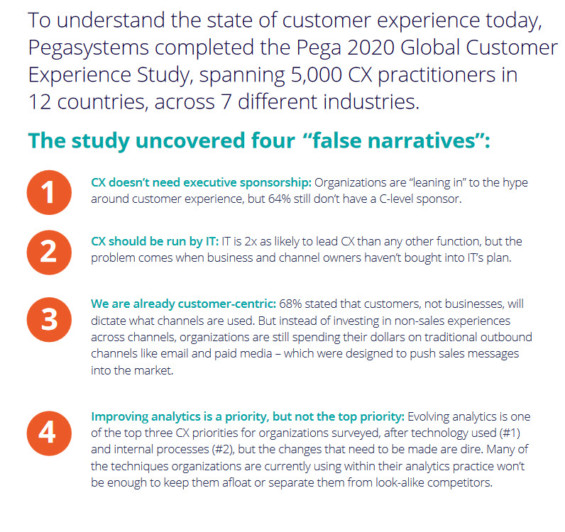
Another boring CX study? For sure not! Pega discovered 4 very important false narratives which underlines the core issue CX has today. A great starting point for a broader view…
Have you thought about the difference between “Customer Experience” and “Customer’s Experience”? Can we build a Customer Experience? What we can do is, to help the customer with his interests, needs and / or pain. With this, we help him to build his own experience. If we try to build the experience for him, this is more called Brand Experience.
However, every experience is build holistic. Customer don’t think in channels, they just want to have the right information at the right time… the place is often coincidental.
The study
The Pega study is a great study which uncovers the 4 most important false narratives of CX. While the study goes in a bit different direction than this article will be, the 4 false narratives are the same.

Pega’s Global Customer Experiene Study 2020 1)Pega’s Global Customer Experience Study
Let’s have a look into this 4 topics and see what they also mean. It is not about repeating the study, it is more a different look on the false narratives Pega discovered.
1) CX doesn’t need executive sponsorship
As mentioned CX requires a holistic approach. The company goal needs to be the customer first and revenue second. Don’t worry, you don’t need o think “but…”, revenue will come. Investing in the customer will always pay off.
The second point is, that we often have different strategies within a company. A sales, a marketing, a product,… strategy. Sometimes one is going left, the other right. What we need is a common vision to align them in the same main direction.
Two points which shows, that we need executive sponsorship. It is not that executives need to be the driver of CX, this can be everyone within a company.
2) CX should be run by IT
That is the same discussion as with Digital Transformation. IT is a huge player and very important, but it can never be the driver… it is always the tooling which helps to reach the goals. For CX we need to listen and understand the customer. Without tools, this is difficult. We also need tools to predict and transport the communication.
There is a huge workload to identify and combine data-silos and make the data usable within the tools. Within an “CX project” this can quickly be over 50% of the workload. This is why we see often the thinking that CX should be run by IT, but this can’t be the reason to run CX by IT.
CX will only run by the customer. Looking into a company, the question is who is the driver here from a department point of view. To be honest, we do not have the right corporate structure today. The closed driver can be marketing if marketing is not acting as a single department. Marketing needs to be the conductor. However, most important is not the question which department, it’s more which person with the best CX mindset should be the driver.
3) We are already Customer Centric
Sure? How can we (as a company) be customer centric if our employees have corporate goals (mainly revenue) instead of customer goals?
Pega is right, we are focussing to much on channels. This is sales, this is marketing,… or this ifs online, this is offline marketing. Every channel has his own goals.
There should b only one channel, the customer. If we think so, we should ask ourself every day at every action: What customer benefit has this?
With this we will quickly come to points where the answer is “no”. If we are asking than why we are doing this, we will discover quickly topics like the employee goals. This is the process to become Customer Centric or close by.
4) Improving analytics is a priority, but not the top priority
It doesn’t matter in which industry we are, these companies who understand their costumer most will survive, other will drop out of sight.
Analytics is key to understand the customer and there is much to do. We have so many data silos, some we know, some not and used are very less. Without listening and understanding we can’t do the right communication and interacting to help the customer build a great experience with our products and services. Without listening and understanding a good experience is a gambling.
Conclusion
So, what do we learn from the study if we think about all this topics? Pega ask “Why is it so hard to catch up to Google or Amazon?” 2)Pega’s Global Customer Experience Study
The answer has two parts. First of all the mindset and second the timing. Google and Amazon started with their efforts many many years earlier, so we need to be quicker today to overtake them… but how can we be quicker if we have not the right mindset and the power to bring this on the road?
We know the Gartner Hype Cycle. We are running from one hype to another and use all the buzzwords instead of internalize the key elements behind and bring them into action quickly. The transformation needs to start within ourself and then with in many, many small projects which will work into the big vision.
What is often seen is, that there are some really good people with the right mindset in a company. Their issue is that they have to convince others and get their trust. Pega is naming “Reduced retention costs” or “Increased return on investment levels” in it’s conclusion for example. This are great points, no question, we need them. In the core of CX they are out of place. This are important points to look at, but as long as wee need them to convince others it will be hard to catch up Google or Amazon.
References
| ⇡1, ⇡2 | Pega’s Global Customer Experience Study |
|---|
